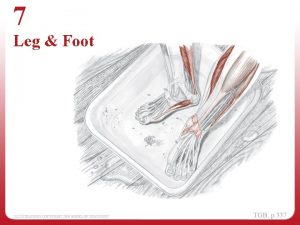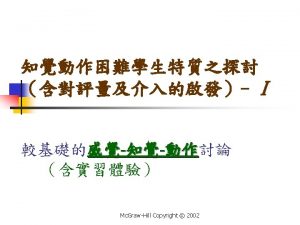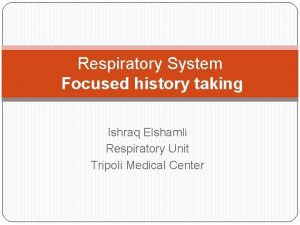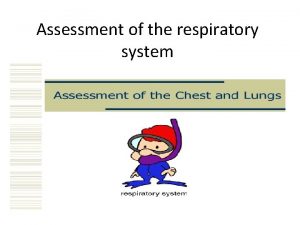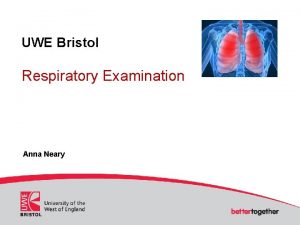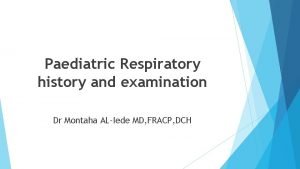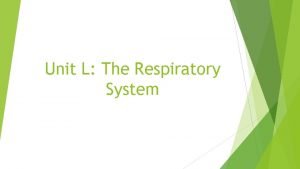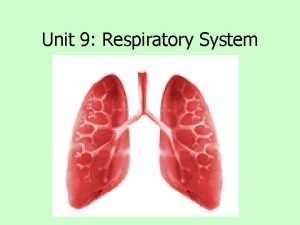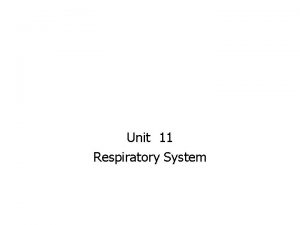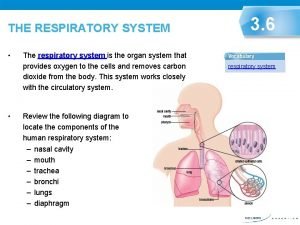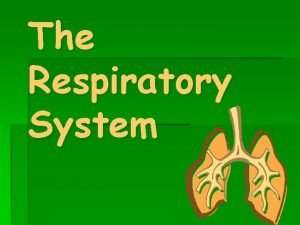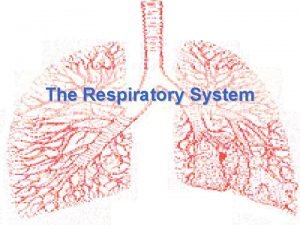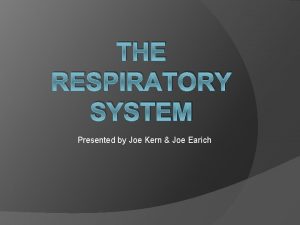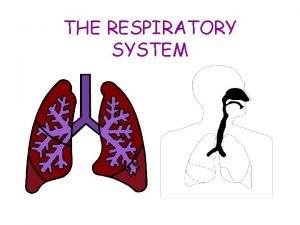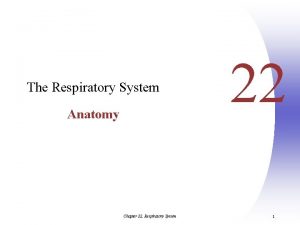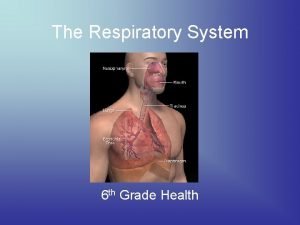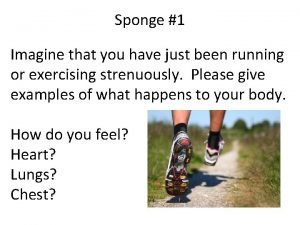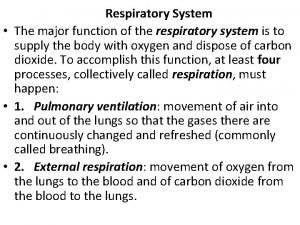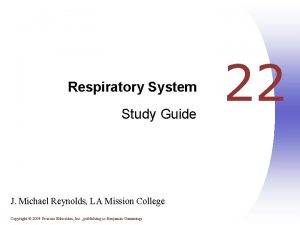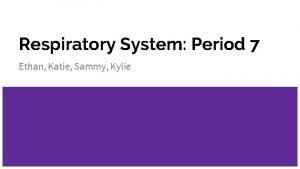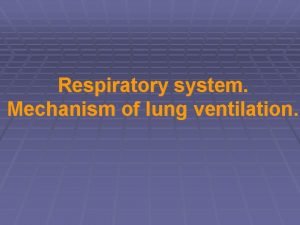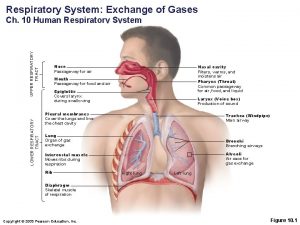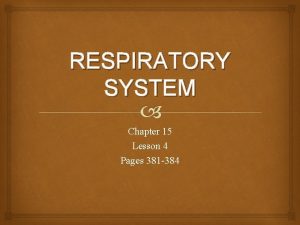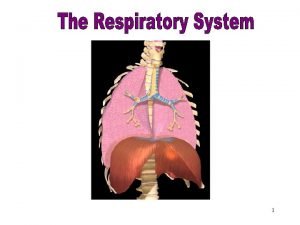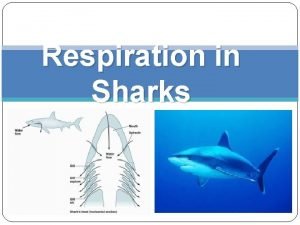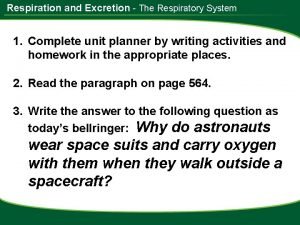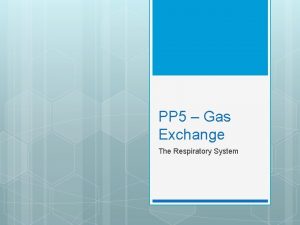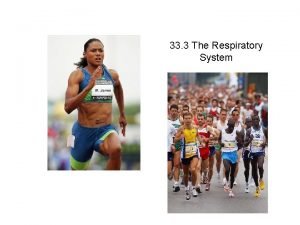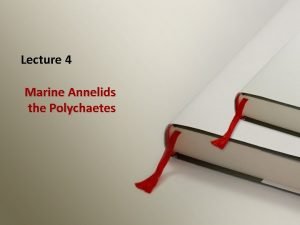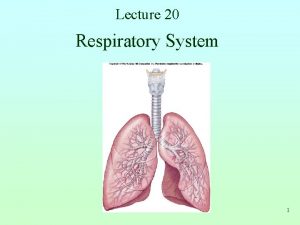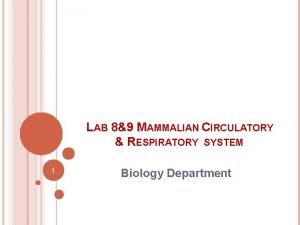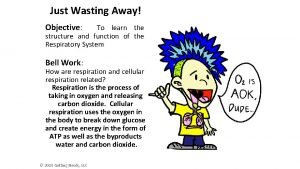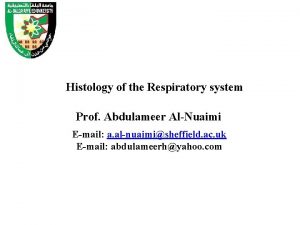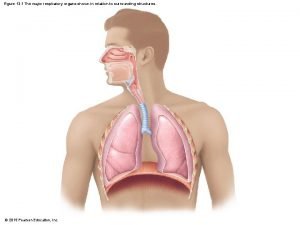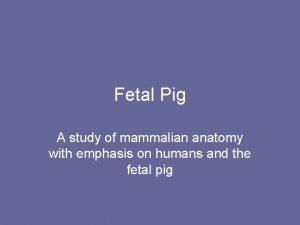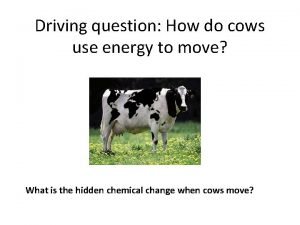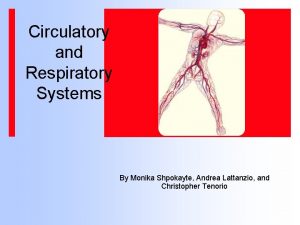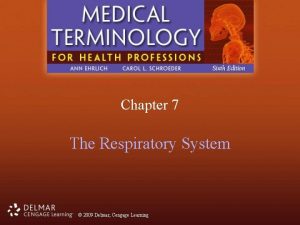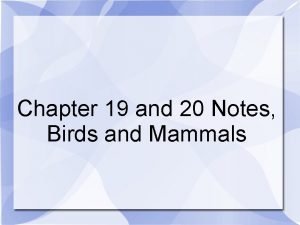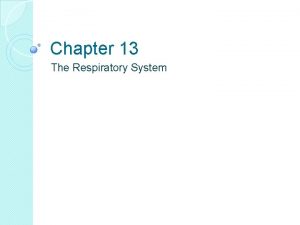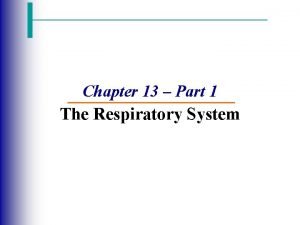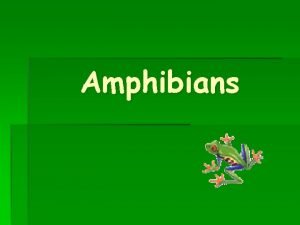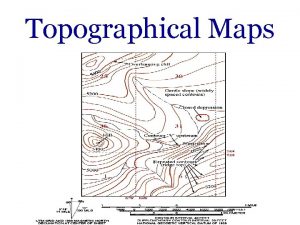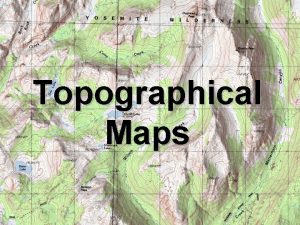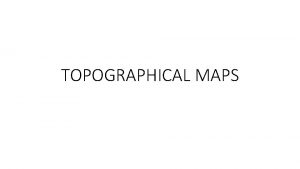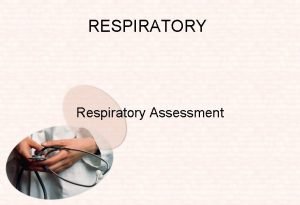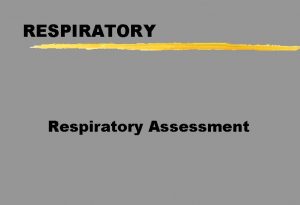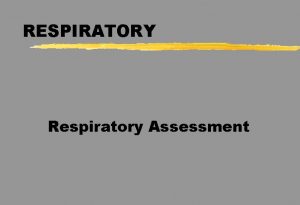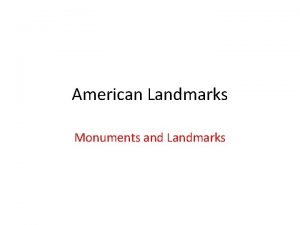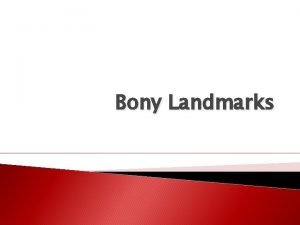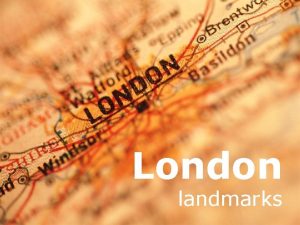Assessment of the respiratory system TOPOGRAPHICAL LANDMARKS History

























































- Slides: 57

Assessment of the respiratory system

TOPOGRAPHICAL LANDMARKS





History • • • Physical problems Functional problems Life style Smoking Past medical history Family Hx Personal and social hx Allergens / environment Anxiety

The basic steps of the examination • • Inspection Palpation Percussion Auscultation

INSPECTION a) Shape of chest – elliptical, symmetrical b) Symmetry of chest – measurement of chest expansion c) Breathing pattern d) Position of trachea e) Intercoastal spaces

Inspection a) Shape of chest: • Barrel chest – over inflation of lungs – anterior-posterior diameter increased.

Inspection • Funnel chest – Depression of the lower portion of the sternum – Complications • Heart damage • i Cardiac output

Inspection • Pigeon chest – Sternum protrudes outward – anterior-posterior diameter • h

Inspection • Scoliosis – Increased Lateral curvature of thoracic spine – Complications • Lung & heart damage • Back problems • Body image

Inspection • Kyphosis • Hunchback – Abnormal increased curvature of the thoracic spine

Inspection • Lordosis • Sway-back – Abnormal, anteriorly increased curvature of the lumbar spine

Inspection: c) Breathing patterns i) Rate • Eupnea – Normal – 12 -20 / min • Tachypnea – h rate – Pnuemonia, pulm edema, acidosis, septicemia, pain • Bradypnea – i rate

Inspection ii) Depth • Hyperpnea – h depth • Hyperventilation – h depth & rate • Hypoventilation – i depth & rate

Inspection • Kussmaul's – h rate & depth – Assoc. with sever acidosis • Apneustic – Prolonged gasping

Inspection iii) Rhythm • Apnea – Not breathing • Cheyne-stokes – Varying depth apnea

Inspection • Biot’s – h rate & depth w/ abrupt pauses

Inspection: d) Tracheal deviation: Normally: centrally aligned Abnormal: shifted to one side • Pleural effusion • Tension pneumothorax • Atelectasis

Inspection e) Intercostal spaces: • Bulging intercostal spaces – Obstruction – Emphysema • Marked retraction of intercostal spaces – Blockage

Palpation a) Identify the areas of tenderness b) Assessment of Respiratory Excursion c) Elicit tactile fremitus

Assessment of Respiratory Excursion. posterior • Place your thumbs about the level of and parallel to the 10 th rib, your hands grasping the lateral rib cage. • As you position your hands, slide them medially in order to raise loose skin folds between your thumbs and the patient's spine. • Feel for range of symmetry of respiratory movement.

Assessment of Respiratory Excursion. Anterior • Place your thumbs along each costal margin with your hands along the lateral rib cage. • As you position your hands, slide them medially a bit to raise a between the thumbs. • Ask the patient to inhale deeply. • Watch for your thumbs to separate as the thorax expands. • Feel for the range and symmetry of respiratory movement

Elicit tactile fremitus • Use the ball of the hand (the palm of the hand at the base of the fingers), palpate and compare like areas of the lungs. . Do not let your fingers touch the patient's chest. • Have the patient repeat a sound that will make full and rich sounds such as "ninety-nine" or "one-oneone. " Symmetrically move your hand over the patient's chest. • You should feel vibrations of equal intensity on either side of the patient's chest.

Percussion Rational • To determine if underlying tissue is filled with air or solid material Procedure • Pt sitting • Tap starting at shoulder • compare right to left

Percussion: results • Resonance – drum like – Normal • Hyper-resonance – Too much air – Emphysema • Flatness / dull – – Fluid or solid Pleural effusion Pneumonia Tumor

Percussion

Percussion

Auscultation of the Lungs Ø Sitting is the optimal position Ø Anterior and posterior walls Ø Expose the chest and ask the patient to breath deeply through open mouth Ø Compare the pitch, intensity and quality of breathing sounds of one side to the other side Ø Perform symmetrically Ø Prevent the patient from fall Ø Prevent the patient from dizziness secondary to hyperventilation Ø Rechecking can be done after deep inspiration

Auscultation Process of listening to sounds within the body specifically breath sounds during examination of the lungs. Breath sounds occur because of movement of air in the airways during inspiration and expiration. Purpose • Asses air flow through bronchial tree Procedure • Diaphragm of stethoscope • Superior inferior • Compare rt to lft

Auscultation: Results Normal • Vesicular – Lung field – Soft and low • Bronchial – Trachea & bronchi – Hollow • Bronchovesicular – – Mixed Between scapulae Side of sternum 1 st & 2 nd intercostal space

Auscultation: Results Adventitious • Crackles (short interrupted sounds due to opening of previously closed airways) • On start of inspiration: problem in large airways • On mid of inspiration: medium airways are closed • On end of inspiration: smaller airways or lung tissues

Auscultation: Results • Wheezes – Sonorous wheezes • Deep low pitched • Snoring • Caused by air narrowed passages • h secretions • Pleural effusion – Sibilant Wheezes • High pitched • Whistle-like • Caused by air narrowed passages • constriction – Asthma

Auscultation: Results • Pleural friction rub – inflammation of pleural membranes, pleural surfaces rub together – Produced due to friction between two surfaces – Grating, creaking sound – Best heard • Anterior, Lower, lateral area

Auscultation: Results • Stridor – Crowing – Partial obstruction of the larynx or trachea

Dyspnea • Significance – Common with cardiac & resp. disease – Sudden onset – healthy person • Pneumothorax – Sudden onset ill, post-op or injury • Pulmonary emboli

Dyspnea • Orthopnea – Sit up to breath • COPD • CHF

Cough is a forced expulsive maneuver against an initially closed glottis, causing a characteristic sound. – Acute: lasting less than 3 weeks – Chronic: more than 8 weeks

Cough Onset Duration Nature Sputum Severity Associated sypmtoms

Sputum Production Definition • Matter discharged from resp. tract that contains mucus and pus, blood, fibrin, or bacteria

Sputum Production Significance • Purulent – Thick, yellow/green – Bacteria • Rusty • Thin, mucous – Viral

Sputum Production • Pink-tinged – Lung CA – TB • Pink tinged, profuse, – Pulmonary edema • Malodorous – Lung abscess

Chest pain Definition • Cardiac or pulmonary

Chest pain Significance • CA (late stage) • Pneumonia • Pulmonary embolism • Pleurisy

Chest pain • Pleurisy – Inflammation of pleura – Sharp with breath – i breath sounds

Clubbed fingers Definition • Sponginess of the nail bed • Loss of the nail bed angle • Finger tip is round and bulbous

Clubbed Finger Significance • chronic hypoxia

Hemoptysis Definition • Expectoration of blood from the respiratory tract

Hemoptysis Significance • Pulm or cardiac • Common causes – – – Pulm infection CA of lungs Pulm. Emboli Pulm. Infarction TB

Hemoptysis • Hemoptysis – Definition? • Coughed up blood – From? • Pulm hemorrhage – Description • Pink, red, mixed with sputum – Blood p. H • Alkaline blood • Hematemesis – Definition? • Vomited blood – From? • Stomach / GI – Description • “Coffee ground” – Blood ph • Acidic blood

Cyanosis Definition • Bluish coloring of skin

Cyanosis Significance • Very late indicator of hypoxia • Appears when O 2 sats < 85% • NOT a reliable sign of hypoxia – Esp. with anemia

Cyanosis • O 2 sat definition – % of hemoglobin carrying oxygen compared to total # of hemoglobin

Cyanosis • Normal Breath 100 O 2 molecules 98 cross into blood Blood: 100 Hgb • O 2 SATS – 98% – No cyanosis

Cyanosis • Hypoxia Breath 100 O 2 molecules 75 cross into blood Blood: 100 Hgb • O 2 SATS – 75% – Cyanosis
 Conducting zone of the respiratory system
Conducting zone of the respiratory system Topographical model of the mind
Topographical model of the mind Leg
Leg Topographical response class
Topographical response class Respiratory digestive and circulatory system
Respiratory digestive and circulatory system History taking of patient
History taking of patient Chest assessment
Chest assessment Tiny air sacs at the end of the bronchioles
Tiny air sacs at the end of the bronchioles Circulatory system and respiratory system work together
Circulatory system and respiratory system work together Vocal fremitis
Vocal fremitis Nottingham city hospital respiratory assessment unit
Nottingham city hospital respiratory assessment unit Paediatric respiratory history
Paediatric respiratory history Bozeman respiratory system
Bozeman respiratory system Unit 9 respiratory system
Unit 9 respiratory system Diagnostic test of respiratory system
Diagnostic test of respiratory system Respiratory system
Respiratory system Voice box respiratory system
Voice box respiratory system Respiratory system coloring page
Respiratory system coloring page Respiratory system purpose
Respiratory system purpose Conclusion respiratory system
Conclusion respiratory system Jobs of the respiratory system
Jobs of the respiratory system Chapter 7 cengage
Chapter 7 cengage Respiratory tree divisions
Respiratory tree divisions Respiratory system
Respiratory system Interesting facts about respiratory system
Interesting facts about respiratory system Upper respiratory system
Upper respiratory system Imagine
Imagine What is the major function of the respiratory system
What is the major function of the respiratory system Respiratory system diagram unlabeled
Respiratory system diagram unlabeled Respiratory system vocabulary
Respiratory system vocabulary Mechanism of respiration
Mechanism of respiration How the respiratory system maintains homeostasis
How the respiratory system maintains homeostasis Respiratory system zones
Respiratory system zones Upper and lower respiratory tract
Upper and lower respiratory tract Chapter 15 lesson 4
Chapter 15 lesson 4 Diagnostic test of respiratory system
Diagnostic test of respiratory system Sharks respiratory system
Sharks respiratory system Draw the flowchart of respiratory system
Draw the flowchart of respiratory system Trachea, trachioles, alveoli
Trachea, trachioles, alveoli Arthropods respiratory system
Arthropods respiratory system Exhalation respiratory system
Exhalation respiratory system Polychaeta digestive system
Polychaeta digestive system What is the conducting zone of the respiratory system
What is the conducting zone of the respiratory system Respiratory system in rabbit
Respiratory system in rabbit The respiratory system just wasting away answer key
The respiratory system just wasting away answer key Bronchus histology
Bronchus histology Sap frog
Sap frog Respiratory organs
Respiratory organs Fetal pig diagram labeled answers
Fetal pig diagram labeled answers Andometr
Andometr Respiratory system flow chart
Respiratory system flow chart Monika shpokayte
Monika shpokayte Chapter 7 the respiratory system labeling exercises
Chapter 7 the respiratory system labeling exercises Chapter 34 circulation in humans concept mapping answer key
Chapter 34 circulation in humans concept mapping answer key Birds respiratory system
Birds respiratory system Chapter 13 respiratory system
Chapter 13 respiratory system Figure 13-1 respiratory system
Figure 13-1 respiratory system Order anura characteristics
Order anura characteristics


